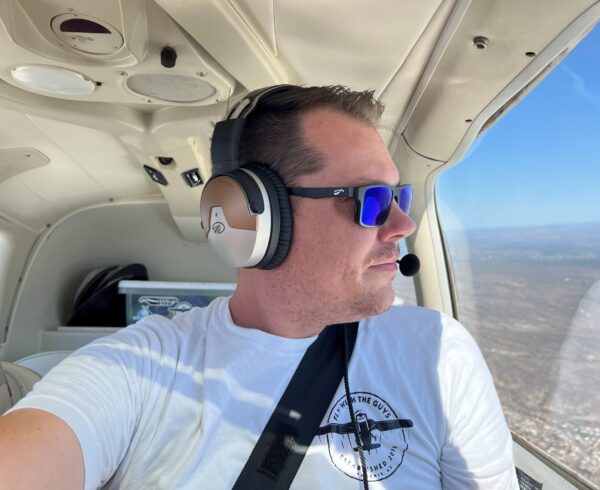Section 1: The Basics of ANR
A good place to start is with one of the most-asked questions that we receive from pilots:
Don’t all active Pilot Headsets work the same way… or do the same thing?
The answer is a simple “yes”…and a much more detailed “no.” It’s yes because the principles of additive cancellation with out-of-phase sound is several decades old and is central to how all aviation active noise systems work. We’ll cover that part first.
There are three elements of an active cancellation system that will be present in every headset. The basic sensing logic of the microphone and “anti-noise” speaker for each ear include:
- A microphone that “hears” the sound levels that have gotten into the dome cavity
- Electronics that will “process” that signal and relay it to the anti-noise speaker
- A speaker (also known as the “ANR driver”) that “adds” sound into the dome cavity
This “added” sound combines with the existing ambient noise to reduces the overall noise level. It’s the “summing” of those signals that represents the active cancellation. How much cancellation can be achieved is a function of many variables we’ll cover later in this section.
What “cancellation” means

First, let’s be clear about what we mean by noise cancellation. We often get questions about whether ANR is just a “masking” sound that “hides” noise, much as a dentist might use music or white noise to “mask” the pain of drilling. Such a “masking signal” approach would inject additional noise into an acoustic environment and cause the ears and/or brain to perceive a different, more acceptable overall frequency response than what was originally present. But obviously, this would not be “cancellation” and is not what an active-canceling headset does.
Active cancellation involves the “addition” of sound waves…one wave mixing with another and dampening its energy. The coming discussion will focus on “analog” cancellation techniques, which is the dominant approach used for headsets today. (We’ll also touch on digital cancellation.) It’s important you understand the physics of what is being done, since this is not a simple task. Particularly as you get to higher levels of cancellation, the demands for precision in each aspect of the design are critical to proper function, as you’ll see.
While it might seem odd to add large amounts of “new” sound energy into the dome cavity and ear canal, that’s exactly how these active systems work. A microphone picks up the frequency and amplitude profile at an instant in time inside the dome cavity, the signal is processed and amplified by the electronics, and an inverted “anti-noise” signal is produced by the active driver to provide canceling sound waves.
Limits on how much cancellation is achievable
The profile of the canceling signal must fall within the contour of the existing noise spectrum to get effective cancellation. At low levels of cancellation, it is relatively easy to provide an inverted signal that fits within the existing noise profile. But the more you try to cancel, the harder it is to keep it functioning properly. If the canceling signal is either over-amplified or distorted in some way, the new signal will partially fall outside of the existing noise profile, and will thus be audible as new noise! In addition, a feedback condition (oscillation or “squealing”) can arise unless the phase and gain of the control loop is carefully managed.
This is what limits how much active noise cancellation a headset can deliver – what technical folks call the “gain” of the system. The gain must be carefully set to make sure the systems has good “stability” – in other words, that it works repeatably and doesn’t oscillate!
Obtaining stable performance with large amounts of cancellation is no small task, particularly when you add in the variables of ear shape, different sized heads, existing cavity shape and designs, etc. All of these are part of the reasons why the answer to our original question “Don’t all active headsets work the same way…or do the same thing?” is an educated, qualified no.
What affects how well ANC works?
We’ve already seen that any active noise cancellation system involves three basic components:
- a noise-sensing microphone
- some processing electronics
- an anti-noise speaker
Getting exceptional performance from an ANC design requires attention to each element of the system we’ve described. Let’s look at each of these three elements in detail.
The “accuracy” of the noise-sensing microphone
To begin with, we need to pick up the most accurate sound replication within the dome if we hope to provide effective cancellation. When we talk about accuracy, we’re really addressing two separate issues:
- Sensitivity and fidelity: how well the microphone reproduces the sound it hears.
- Correlation: how closely the sound that the microphone picks up corresponds to the sound your ear hears.
The first issue (sensitivity and fidelity) is important, but it’s an easy problem to solve because there are many very good mics available for a manufacturer to use. It’s the second issue (correlation) that’s the difficult part of getting good information into the cancellation system. Simply put, an ideal system would cancel noise right in your ear canal, not just at a mic positioned somewhere in the dome. While it’s not practical to stick a mic in your ear canal, a good headset design can go a long way to ensure that what the mic picks up is very close to what your ear hears. To get this right, it’s important to know some things about the ear opening and the acoustic cavity we’re working in.

- Is this a “left” or a “right” ear cup? Although ears come in a lot of shapes and sizes, it turns out statistically that the ear opening is not symmetrically “centered” within the dome…it is forward and below center. The mic placement must accommodate human physiology to deliver optimal performance. Consequently, the best performance is attained when ear cups are designed to fit specific ears (left and right). You’ll notice in the diagram that the domes are tilted and shaped to better fit the ear, and that the mounting plates that hold the mic and active speaker are also angled to better profile the ear shape in the dome. Attention to these ergonomic and acoustic details substantially improve both comfort and performance. (It’s interesting to note now that more manufacturers are at least noting this important feature in their documentation. Even headsets that can be reversed should not be worn that way!)
- What is the position of the microphone relative to the ANR driver and the ear opening? The location of the mic has everything to do with the effects the active driver output has on it. If the mic is directly above or next to the driver, you will get a stable, closed loop cancellation (with good predictable cancellation) but have noticeably less cancellation at the ear opening! Many of the “claimed” cancellation numbers you read in ads and spec sheets are measured at the mic…not the ear opening. Obviously, what we want is the highest cancellation at the ear. Without getting too technical, then, mic position is a key contributor to just how much cancellation you’ll get in your ear. This is not just acoustic theory and principles…you really can hear a difference when attention has been paid to these details of design. When it’s all said and done, you just have to listen to various ANR headsets and compare them in your plane!
The sophistication of the processing electronics

The signal from the microphone is sent through the electronics and is amplified or “processed.” There will be substantial differences in delivered cancellation depending on the design of the acoustic cavity, the mic placement issues already covered, and the gain levels the design will support. The actual performance can be measured and plotted for comparison. Such a profile of performance for several headsets is shown in this graph.
You’ll note the graph charts frequency and depth (in dB) of the cancellation. There are significant variations in active canceling effectiveness for pilot headsets on the market today. We’ll cover this graph and similar ones in great detail in Section 2 of this series….so you can begin to make educated judgements about comparative performance.
The sophistication of the electronics, amplifiers, and audio filters has a great deal to do with overall headset performance. The differences can be seen in more than just the effectiveness of cancellation. The way the audio is processed will affect what you actually hear. Examples include:
- The communications audio…what you hear from your comm radio. The less sophisticated ANR systems process the audio together with the ambient noise. The result is that the low frequency components of the radio and audio communications are cancelled along with the noise. This causes frequency response to be degraded, sounding tinny and unnatural. More sophisticated ANR systems process the signal and noise separately, allowing for full reproduction of the original audio signal.
- The Signal-to-Noise ratio…what you’re looking to ANR to improve. All active products provide at least a modest S/N improvement when the masking effects of loud, low frequency noise are reduced. More sophisticated designs boost the signal levels to further enhance intelligibility, producing clearer communications…particularly for those who have suffered some hearing losses already.
Both of these are tangible examples of real differences among different ANR headset designs. Again…hearing is understanding!
The effectiveness of the speaker
After sampling the ambient dome sound profile (hopefully well-correlated to the ear opening!) and processing that signal for proper fidelity, the system needs to produce the canceling “waves” of sound effectively and efficiently.
Speaker “effectiveness” would be measured by how closely the wave profile produced matches the input mic signal. The long, low-frequency “waves” are most critical to canceling of the 50-300 Hz. noise so prevalent in piston engine airplanes. More effectiveness will translate into better low-frequency cancellation. With the highest decibel levels in most planes between 80-120 Hz., you want a headset that provides maximum performance in that part of the noise spectrum. (In Sections 2 and 3 of this series, we’ll learn more about specific headset cancellation performance and the actual airplane noise spectrum.)
Many people are put off by the size and hassle of the external battery modules associated with ANR headsets. Some of today’s headsets come with large power packs that hang on separate cables, while others have small modules that are attached in-line to the communications cable. To achieve 30+ hours of operation, some systems require as many as ten AA batteries, while others require just two! That’s a big difference and worth investigating before you finally purchase a headset.









